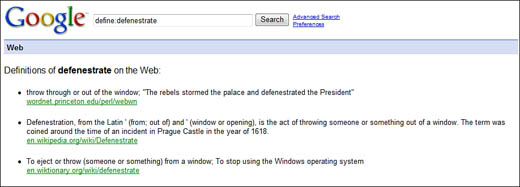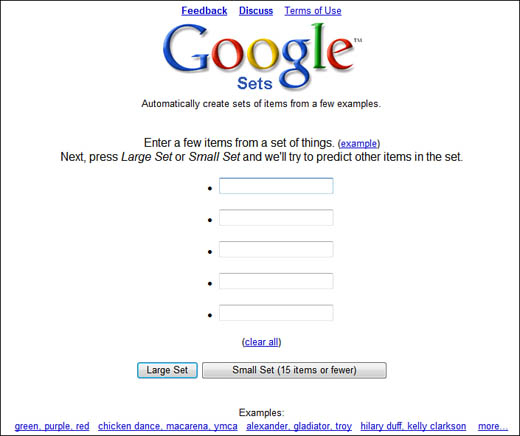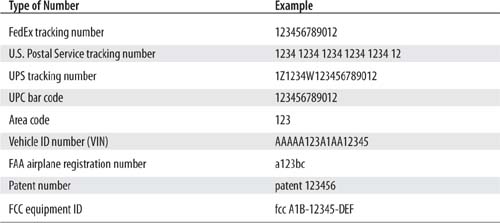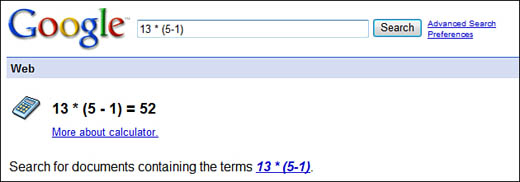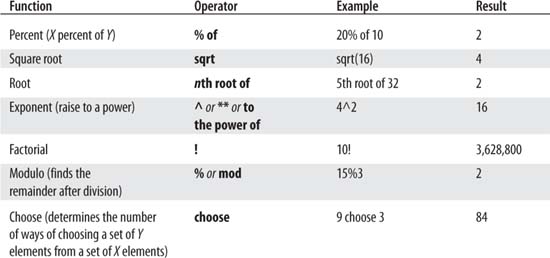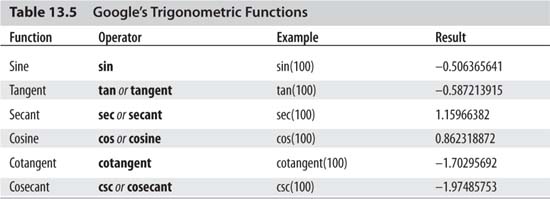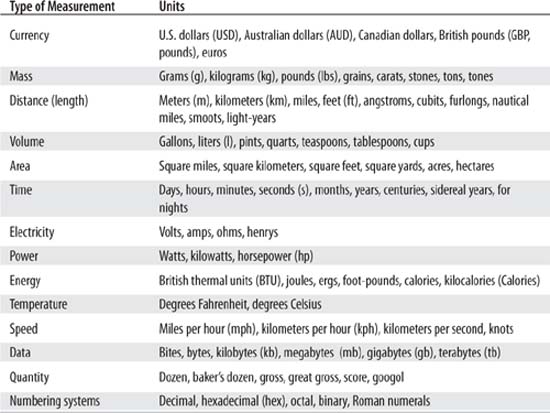If you’re like me, every now and then you need (or want) to look up information about a particular person. I’m not talking about famous personages here, but rather normal people whose addresses or phone numbers I can’t remember.
As far as Google is concerned, a person’s name, address, or phone number is just another piece of information stored in the database. The techniques to retrieve this information, however, are a little different from normal Web search techniques.
As part of its massive database of information, Google includes listings for millions of U.S. households in what it calls the Google PhoneBook. You search the PhoneBook listings from the main Google search box using specific query parameters.
You start a PhoneBook search with the phonebook: operator, followed by the person’s name. To narrow your results, you need to include more information than just the name, such as the person’s city, state, or ZIP code. There are six ways you can search for a person or household in the Google PhoneBook. Table 13.1 details each of these methods, along with an example for each.
As you might suspect, the more details you provide, the more targeted your results will be. Searching for all the Smiths in Minneapolis will produce a higher number of results (most of them unwanted) than searching for all the John Smiths. Searching for all the John Smiths in a particular ZIP code would be much more efficient than searching for all the John Smiths in an entire state.
Caution
Because it takes so long to get change-of-address information into the system, Google PhoneBook listings may not always be up-to-date; new numbers may not always be listed, and old numbers may take some time to get removed. In addition, Google can display only names that are publicly available. If a person’s phone number is unlisted, it isn’t displayed.
When you enter your query using one of these methods, Google returns a Residential PhoneBook search results page. The top matching names are listed, along with each person’s phone number, street address, and a link to a map of this address (via Google Maps).
After Google has captured name, address, and phone number information in the PhoneBook, it’s an easy enough task to search that information in a variety of ways. One such approach is to do a reverse phone number lookup, in which you enter a phone number and Google tells you who the number belongs to.
To conduct a reverse phone number search, all you have to do is enter the full phone number, including area code, into the standard Google search box. You can enter all 10 numbers in a row, without hyphens (like this: 1234567890), or use the standard hyphenated form (like this: 123-456-7890); Google accepts either method. When you click the Search button, Google displays a single matching PhoneBook result.
Tip
If you’d rather not have your phone number available for everyone on the Web to Google, you can have your phone information removed from Google’s database by following the instructions at www.google.com/help/pbremoval.html.
Commentary
Want to look up the definition of a particular word, but don’t want to bother pulling out the old hardcover dictionary? Not sure of a specific spelling? Use Google as an online dictionary to look up any word you can think of. It’s easy, and there are two ways to do it—plus an interesting third approach that helps you generate words on the fly.
The first approach to looking up definitions is to use a little-known Google feature, known as a “what is” search. All you have to do is enter the keywords what is in your query, followed by the word in question. No question mark is necessary. For example, to look up the definition of the word “defenestrate,” enter what is defenestrate.
When you use a “what is” search, Google returns a standard search results page (typically with several useful definition links in the list), as well as a single Web definition in a OneBox result at the top of the page. As you can see in Figure 13.1, this OneBox result includes a short definition of the word and two useful links. The first link, disguised as the result title, is actually a link to other definitions of the word on the Web. The second link, Definition in Context, displays an example of the word used in a sentence. (This in-context usage is supplied by the same site that supplies the main definition.)
There’s something even more useful on the “what is” search results page. If you look in the statistics bar, you’ll see the word you searched for displayed as a link. Click this link, and Google displays the full dictionary definition of this word from the Answers.com website. This page includes a pronunciation of the word, as well as one or more definitions.
Even more definitions are available when you use the Google Glossary feature. Even though it’s called Google Glossary, it’s really just another advanced search operator that produces some very specific results.
The operator in question is define:. Use this operator before the word you want defined, with no space. For example, if you want to define the word “defenestrate,” enter the query define:defenestrate.
When your query includes the define: operator, Google displays a special definitions page, as shown in Figure 13.2. This page includes all the definitions for the word that Google found on the Web; click a link to view the full definition.
Note
Answers.com (www.answers.com) offers all sorts of information, including—but not limited to—dictionary definitions. Its definitions are sourced from The American Heritage Dictionary.
And here’s something else to know. If you want to define a phrase, use the define: operator, and put the phrase in quotation marks. For example, to define the phrase “peer to peer,” enter the query define:“peer to peer”. Without the quotation marks, Google would define only the first word in the phrase.
Our final word-related search feature is one that’s still in development at Google Labs. I’m talking about Google Sets. You enter two or more related words, and Google Sets displays similar terms to complete the set.
You access Google Sets at labs.google.com/sets. As you can see in Figure 13.3, the main Google Sets page is actually a form. All you have to do is enter a few terms from the set you want to complete, and then click either the Large Set or Small Set button.
Tip
If you enter the keyword define—not the define: operator—with a space between it and the word you want defined, Google returns the same results as if you entered a “what is” query.
The resulting page displays a longer list of terms predicted from the short list you entered. You can expand this list by clicking the Grow Set button beneath the list.
For example, if you enter the terms round, square, and rectangle, Google Sets returns the terms triangle, oval, circle, hexagon, and so forth. If you enter the terms dog, cat, and bird, Google Sets returns the terms horse, rabbit, fish, snake, and so forth.
Note
Learn more about Google Labs in Chapter 2, “Google Labs: How Google Develops New Applications.”
How might you use Google Sets? One use is to help “fill in the blanks” when you’re writing or creating lists. Another use might be to expand your own set of query terms when you’re using Google to search an unfamiliar subject.
When you’re looking for hard facts, Google might be able to help. Yes, Google always returns a list of sites that match your specific query, but if you phrase your query correctly—and are searching for a fact that Google has preidentified—you can get the precise information you need at the top of the search results page.
What types of information are we talking about? Fact-based information, such as birthdates, birthplaces, population, and so on. All you have to do is enter a query that states the fact you want to know. For example:
-
To find the population of San Francisco, enter population san francisco.
-
To find where Mark Twain was born, enter birthplace mark twain.
-
To find when President Bill Clinton was born, enter birthday bill clinton.
-
To find when Raymond Chandler died, enter die raymond chandler.
-
To find who is the president of Germany, enter president germany.
The answers to these questions are displayed in a OneBox section at the top of your search results page. You get the precise answer to your question, according to the referenced website. Click the associated link to learn more from this source.
This capability to display “quick answers to straightforward questions” is called Google Q&A. The information presented is typical reference information, the kind of stuff you might find in a desk reference or almanac. Google Q&A isn’t always consistent about the sources of this info, or about the specific facts that are displayed. For example, searching for distance to mars returns no quick fact; neither does height empire state building or size football field. So accept what you get, and recognize that Google is selective about the facts it knows.
Did you know that Google can be used to find and display current weather conditions and forecasts? It’s a pretty easy search; all you have to do is enter the keyword weather, followed by the location. You can enter the location as a city name, city plus state, or ZIP code. For example, to view the weather forecast for Minneapolis, enter weather minneapolis.
As you can see in Figure 13.4, Google displays current weather conditions and a four-day forecast at the top of the search results page. Although this is a good summary report, you may want to click through to the more detailed forecasts offered in the standard search results listings below the four-day forecast.
Weather information is important to travelers, as is information about flight delays and airport weather conditions. Fortunately, you can use the main Google search page to search for this information, just as you did with weather forecasts.
To search for weather conditions and delays at a particular airport, all you have to do is enter the airport’s three-letter code, followed by the word airport. For example, to view conditions at the Minneapolis-St. Paul International Airport (whose code is MSP), enter msp airport. This displays a link to conditions at the chosen airport, as provided by the FAA. Click this link for detailed information.
Google also lets you track the status of any U.S. flight, and many international flights. All you have to do is enter the flight number into the Google search box. For example, to find out the status of United Airlines flight 116, enter ua116. Google displays a link to the real-time status of the specified flight, courtesy of the FlightStats website (www.flightstats.com). Click this link to view the current status of the flight.
Airline flights aren’t the only numbers you can look up with Google. Google lets you enter all sorts of numbers into its main search page and then displays the relevant information at the top of the search results page.
For example, if you want to track a package that was sent via UPS, all you have to do is enter the UPS tracking number. If you want to see what product is attached to a specific UPC (universal product code), just enter the bar code number. If you have an area code and you want to know which city it serves, enter the area code.
Note
In most instances, all you have to enter is the number itself, with no associated operator. The only exception is if you’re searching for an FCC equipment ID or patent number; in these instances, enter the keyword fcc or patent before the ID number.
Table 13.2 details all the different types of numbers that Google can look up for you.
If you’re a student or alumnus, Google makes it easy to search specific university sites using something called University Search. University Search works by limiting your search to pages housed on a specific university website; you’re searching a single university site, not the entire Web.
As of this writing, Google lists site-specific searches for more than 600 institutions worldwide, from Abilene Christian University to York University. You can use University Search to search for course schedules, admissions information, and the like. Just go to the University Search page (www.google.com/options/universities.html) and select the university you want to search. When the next page appears, enter your search query and click the Search button. That’s all there is to it!
As you’ve no doubt surmised, Google’s University Search works by restricting the search to a specific domain, using the (hidden) site: operator. Well, nothing stops Google from using a similar strategy to offer other site- and topic-specific searches—which leads us to our next batch of special searches.
Knowing that a large number of people use the Internet to search for computer- and technology-related information, Google has created several technology-related special searches. You can use these specialty searches to find technical support, software updates, downloadable software, and other computer-related information and services.
There are four of these technology-related searches, each focused on a specific computer platform:
-
Google Microsoft Search (www.google.com/microsoft) searches the main www.microsoft.com domain and other Microsoft-related sites.
-
Google Apple Macintosh Search (www.google.com/mac) searches the main www.apple.com domain and other Apple-related sites.
-
Google Linux Search (www.google.com/linux) searches a variety of Linux-related sites.
-
Google BSD UNIX Search (www.google.com/bsd) searches a variety of sites that specialize in the BSD version of the UNIX operating system.
Looking for information about the United States government? Use Google’s U.S. Government Search (www.google.com/unclesam). As you might suspect, this search focuses solely on U.S. government websites—which makes it the best place to search for official government forms, information, reports, and the like.
When you access U.S. Government Search, Google directs your search to all the sites within the .gov domain, which includes sites for all major U.S. government agencies, Congress, and the White House. And, so as not to be too federalist, U.S. Government Search also searches all the individual state government sites in the .us and .gov domains. Suffice it to say, if it’s government-related, U.S. Government Search will find it.
Here’s something few Google users know. You can use Google as a calculator, and to perform conversions and look up constants. This is one of the coolest “hidden features” in the Google universe—and you’re reading about it here!
Tip
If you want to search for documents that contain the equation you entered, rather than calculate the results of the equation, click the Search for Documents Containing the Terms link on the search results page.
To use Google as a calculator, all you have to do is enter your equation or formula into the search box and then click the Google Search button. The result of the calculation is displayed on the search results page, as shown in Figure 13.5. It’s that simple.
You can use a number of algebraic operators to construct your calculations. Table 13.3 details the operators that Google recognizes.
Note that several functions have multiple operators you can use. For example, for addition you can use either +, plus, or and. That means you can add the numbers 2 and 3 in three different ways:
-
2 + 3
-
2 plus 3
-
2 and three
And you don’t have to enter spaces between the operator and the numbers (unless you’re spelling them out). So 2 + 3 is just as good a query as 2+3. Google’s smart enough to figure out what you mean.
Google also lets you string multiple operations together. For example, if you want to calculate 12 times 5 divided by 4, enter 12 * 5 / 4. The calculations work from left to right, multiplying and dividing first, and then adding and subtracting. So, using another example, 2 + 3 * 3 equals 11, not 15.
You can also create nesting equations by using appropriately placed parentheses. So, to divide the sum of 4 plus 3 by the sum of 5 plus 2, you’d enter (4 + 3) / (5 + 2). You can get as complex or creative as you want; Google can handle it.
Google’s calculator isn’t limited to basic addition and multiplication. It can also handle more advanced calculations (detailed in Table 13.4), trigonometric functions (Table 13.5), inverse trigonometric functions (Table 13.6), hyperbolic functions (Table 13.7), and logarithmic functions (Table 13.8). If you know what these functions are, I assume you know the proper way to use them. If you don’t, get yourself a good math book, or don’t bother with them.
In addition to performing calculations, Google knows a variety of mathematical and scientific constants, such as pi, Avogadro’s number, and Planck’s constant. It also knows the radius of the Earth, the mass of the sun, the speed of light, the gravitational constant, and a lot more.
Let’s check this out. Not sure what the value of pi is? Enter pi, and Google returns 3.14159265, as shown in Figure 13.6. How about the speed of light? Enter speed of light, and Google returns 299,792,458 m/s. What about the radius of the Earth? Enter radius of earth, and Google returns 6378.1 kilometers.
Now let’s get fancy. Try dividing the radius of the Earth by pi. Enter (radius of earth) / pi; Google’s answer is 2030.21229 kilometers. Or how about multiplying the radius of the Earth by the speed of light and then dividing the answer by Avogadro’s number? I’m not sure why you’d want to do this, but the query looks like this: (radius of earth) * (speed of light) / (avogadro’s number). The answer is 3.17512652 × 10–09 m2/s.
And what constants does Google know? Here’s a short list, with shorthand entries in parentheses:
-
Astronomical unit (au)
-
Atomic mass unit (amu)
-
Avogadro’s number
-
Boltzmann constant (k)
-
Electric constant (epsilon_0)
-
Electron mass (m_e)
-
Electron volt (eV)
-
Elementary charge
-
Euler’s constant
-
Faraday constant
-
Fine-structure constant
-
Gravitational constant (G)
-
Magnetic flux quantum
-
Mass of moon (m_moon)
-
Mass of planet (m_planet, as in m_earth)
-
Mass of sun (m_sun)
-
Molar gas constant (R)
-
Permeability of free space
-
Pi
-
Planck’s constant (h)
-
Proton mass (m_p)
-
Radius of moon (r_moon)
-
Radius of planet (r_planet, as in r_mars)
-
Radius of sun (r_sun)
-
Rydberg constant
-
Speed of light (c)
-
Speed of sound
-
Stefan-Boltzmann constant
For example, if you wanted to find the speed of light, you could enter speed of light, or you could just enter a capital C. Google knows the value both ways.
Another surprise is that Google’s calculator also handles conversions. It knows miles and meters, furlongs and light-years, seconds and fortnights, and even angstroms and smoots—and it can convert from one unit of measurement to another.
Note
Google’s currency conversion rates are provided by Citibank N.A. and may not always be the most current rates.
The key to using the Google calculator as a converter is to express your query using the proper syntax. In essence, you want to start with the first measure, followed by the word “in,” followed by the second unit of measure. A general query looks like this: x firstunits in secondunits.
Let’s look at some examples.
Don’t know how many feet equal a meter? Enter the query 1 meter in feet; the result is shown in Figure 13.7. Not sure how many teaspoons are in a cup? Enter 1 cup in teaspoons. Want to convert 100 U.S. dollars into euros? Enter 100 usd in euros. Or how about converting 72 degrees Fahrenheit to Celsius? Enter 72 degrees Fahrenheit in Celsius. Or maybe you want to find out your weight in kilos, or your age in seconds. Enter the queries 180 pounds in kg or 45 years in seconds.
All the formulas necessary for these types of conversions are hardwired into the Google search engine. Just state your query as clearly as possible, and Google does the rest.
What units of measure does Google know? Table 13.9 lists just some of what you can find when you search Google.
Google even lets you do some nonsensical conversions. You can query speed of light in knots or 1 foot in smoots. You can also use these conversions to create nonsense calculations, such as (radius of earth) / 3 teaspoons. It doesn’t make any sense, but Google can do it. (And you get the wonderfully absurd measurement of “kilometers per liter.”)
Tip
Google’s calculator has been hardwired to include the answers to some fairly complex—and fairly fanciful—calculations. My favorite is to enter the query what is the answer to life the universe and everything. Google’s answer, 42, should delight fans of Douglas Adams’s The Hitchhiker’s Guide to the Galaxy.



